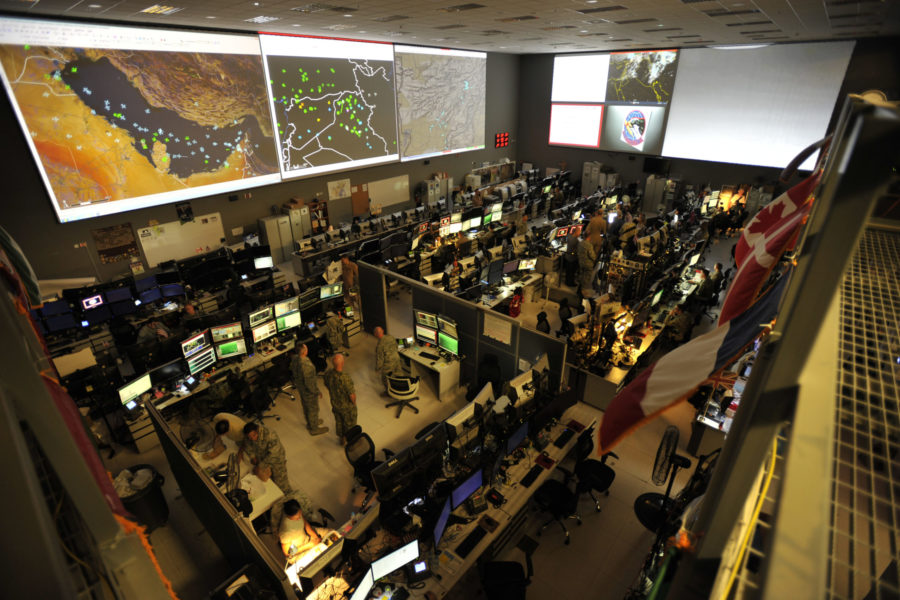The Air Force is looking for ways to combine artificial intelligence and interactive gaming technology to revolutionize and dramatically shorten the process of planning complex air attack operations.
At two industry days Dec. 8 and 9, the Air Force Research Laboratory’s Information Directorate in Rome, N.Y., asked interested vendors to submit white papers by Jan. 10 explaining how they would use each of these new technologies to augment human decision-making in the planning cycle and slash the time taken to produce a master air attack plan (MAAP) from 36 hours or more to four. The program, called Fight Tonight, provides a total of $99 million in funding, which AFRL expects to hand out in two phases, each featuring two or more separate awards of between $3 and $40 million.
“These master attack plans are at the theater level,” Jeffrey Hudack, the Fight Tonight technical director, told Air Force Magazine. “They cover all our forces in theater—resource and target allocation, materiel and logistics, airspace management—there are thousands of assets …. Tasking them all together, figuring out the most effective way to achieve objectives, is an incredibly complex undertaking.”
The length and complexity of the MAAP planning cycle means commanders don’t generally get presented with more than a handful of options, added Fight Tonight Program Manager Lt. Col. Sean Carlson. “Because the process is incredibly cumbersome, you really have to commit to one course of action early on so that you can effectively plan your logistics and align all the other pieces to make it happen.” But that comes at a heavy price: “Because the process takes so long, and the environment is so dynamic, oftentimes, by the time [the planning] is done, the landscape has changed so much that your initial plan has lost effectiveness.”
Artificial intelligence could dramatically shorten that planning process, Hudack explained. “AI is very good at situations where we have known quantities—managing fuel requirements, matching weapons to targets, knowing how many aircraft of which type you need for a particular task,” he said. For instance, making a series of incremental adjustments to a plan, which would involve recalculating fuel demands and multiple other cascading changes, currently takes many hours. Fight Tonight would make it possible in minutes.
On the other hand, Hudack said, humans are better at assessing less easily quantifiable factors. In drawing up the MAAP, there may be “political considerations, or other considerations that aren’t really amenable to being read by a machine,” he said. “What we’ve come to realize is that there are certain things AI is good at, and there are certain things humans are good at, and navigating that line is really where the value comes.”
The announcement says that, based on the white papers, AFRL may invite one or more vendors to submit detailed technical proposals by Feb 25. Fight Tonight is sponsored by AFRL’s Transformational Capabilities Office.
The biggest changes from Fight Tonight, said Carlson, will come in the ease with which alternative possible options can be generated and assessed, making it possible to explore the trade-offs between different courses of action. “You’re talking about going from two or three possible options to hundreds,” he said.
Assessing those much larger collections of options is where the second kind of new technology, interactive gaming, comes in, Hudack added. “You can’t just hand over a bunch of spreadsheets and say, ‘Here’s all the data you need to make your decision.’ … The gaming industry has decades of experience designing user interfaces that take you right to the high-level information you need and then allow you to drill down into the finer-grained data.”
The idea is to integrate the two kinds of technology into a single user interface that can be connected to the real-life data sources available to mission planners in an Air Operations Center, or AOC.
The program envisions a two-stage development process. In Phase 1, vendors will spend two-and-a-half years developing and prototyping the technology. In Phase 2, they’ll have two years to test, integrate, and eventually install it in a real AOC.
Fight Tonight will have a radical impact on the way planners do their jobs, said Hudack, which was why the two-phase process was important: “You have to co-evolve the technology and the concepts of operations” that employ it, he said.
Editor’s note: This story was updated at 10:08 a.m. Dec. 16 to correctly refer to master air attack plans (MAAPs).

